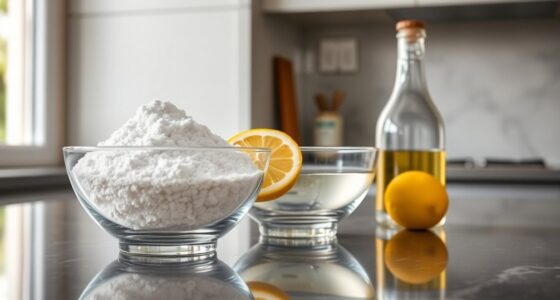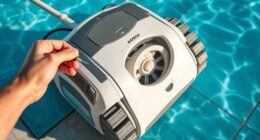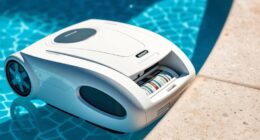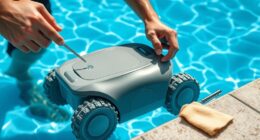Warm weather brings excitement for boating and water sports. But did you know? Your watercraft can spread harmful aquatic invasive species. These invaders pose a serious threat to our delicate ecosystems1.
Experts warn that uninformed boaters may spread aquatic nuisance species (ANS). This happens when boats travel between lakes or from lakes to rivers1. Both large and small boats can carry these unwanted hitchhikers.
Prevent the spread by making boat cleaning a regular habit. Clean your boat before and after each launch. This simple routine helps protect our waterways and native species.
Key Takeaways
- Cleaning off visible aquatic plants, animals, and mud from all equipment before leaving water access can help prevent the spread of aquatic invasive species2.
- Draining motor, bilge, livewell, and other water-containing devices before leaving water access is crucial in preventing the spread of aquatic invasive species2.
- Drying equipment for at least five days or wiping with a towel before reuse can help eliminate small and nearly invisible organisms2.
- Disposing of unwanted bait, worms, and fish parts in the trash is recommended to prevent the spread of aquatic invasive species2.
- Taking steps to clean, drain, and dry equipment can greatly minimize the risk of spreading aquatic invasive species to new locations2.
Introduction
Aquatic invasive species threaten our waterways, ecosystems, and native wildlife. These non-native organisms disrupt aquatic environments and cause millions in damage3. Over 90 non-native species have been found in Long Island Sound, with recreational boating a key transfer method3.
These invaders clog waterways, damage infrastructure, and harm local economies. In the U.S., there are more than 250 non-native aquatic species from other continents4. Over 450 non-native aquatic species from North America have moved outside their native ranges4.
Invasive species can be introduced through dumping aquariums or stocking lakes. They also spread unintentionally through boating, fishing, and diving4. Preventing their spread is vital for protecting our waterways and diverse aquatic life3.
In Connecticut, transporting aquatic plants on vessels or trailers is now illegal. Violators face fines up to $100 per plant and mandatory court appearances3. Clean, drain, and dry your boat and gear after each use to protect our aquatic environments4.
Use high-pressure, hot water (120 to 140 F) to clean boats and equipment. Dry gear for at least five days or wipe with a towel to remove living material4.
Protecting waterways from invasive species is everyone’s job. WDFW got $3.6 million to monitor and prevent quagga and zebra mussels in Snake and Columbia Rivers5. In 2025, WDFW inspected over 58,000 watercraft and cleaned 25 mussel-fouled boats5. Together, we can safeguard our natural resources and aquatic ecosystems5.
Steps to Clean Your Boat and Gear
Cleaning your boat, trailer, and gear helps prevent aquatic invasive species from spreading. Before leaving a launch area, inspect your watercraft and equipment thoroughly. Remove any visible mud, plants, fish, or other organisms you find.
Inspect and Remove Visible Mud, Plants, and Animals
Check your boat, trailer, and all gear carefully. This includes anchors, life jackets, and fishing equipment. Take off any mud, plants, or animals and leave them where you found them.
This simple step helps stop the spread of invasive species. It can prevent zebra mussels and hydrilla weed from reaching new waters6.
Eliminate Water from All Equipment
Drain all water from your equipment. This includes bilges, live wells, and other water-holding areas6. Even small amounts of water can carry microscopic invasive species67.
For jet boats and personal watercraft, run the engine for 5-10 seconds. This helps blow out excess water and vegetation7.
By cleaning your boat, you help protect our waterways from harmful aquatic invasive species6. Your actions make a big difference in keeping our waters healthy.

“Cooperation to prevent the spread of aquatic invasive species is mandated by law in many states.”6
Cleaning and Drying Your Boat and Gear
After removing debris and water, the next step is thorough cleaning and drying. This prevents aquatic nuisance species from spreading. Clean your boat, motor, trailer, and all equipment carefully2.
Use Hot Water to Clean
Clean your equipment with hot water (at least 120°F). The heat effectively kills many invasive species. Flush your motor with hot water for 2 minutes2.
Pressure Wash When Possible
Pressure washing is great for cleaning boat hulls and hard-to-reach areas. It removes aquatic plants, animals, and mud. Use high-pressure, hot water for thorough cleaning2.
After cleaning, let everything dry completely. This step is crucial in eliminating aquatic species. Dry equipment for at least five days or wipe with a towel2.
Avoid using chemical disinfectants like bleach on watercraft and gear. They can harm equipment, the environment, and human health2.
By following these cleaning methods, you protect native species and the environment. You also safeguard the economy, recreation, and human health2.

Draining Bilges, Live Wells, and Other Water-Holding Areas
Draining your boat’s water is vital to stop aquatic invasive species. Remove the drain plug at the launch site. Empty bilges, live wells, and other water-holding equipment completely.
This removes microscopic organisms, even if the area looks clean. Boaters must open or remove all drain plugs, except in specific cases. Trailered boats need all water drainage devices opened or removed.
Check your boat right after loading. Remove any visible plants, animals, or mud before leaving. Drain all water on land, including live wells and coolers.

| Measure | Impact |
|---|---|
| Draining bilges, live wells, and other water-holding areas | Eliminates microscopic organisms and reduces the risk of invasive species spreading to new locations |
| Removing visible plants, animals, and mud before leaving the launch site | Prevents the transport of aquatic invasive species to uninfested waters |
| Draining all water from the boat before departing | Ensures no remaining water can facilitate the spread of invasive species |
These simple steps protect our waterways from aquatic nuisance species. It’s our job to safeguard natural resources for future generations. Your actions make a real difference8.
“Aquatic invasive species, such as variable milfoil and Asian clams, damage waterbodies and decrease property values, affecting tourism and recreation.”8
Let’s fight invasive species by draining boats and gear thoroughly. Your efforts help preserve our beautiful water bodies. Together, we can protect our precious aquatic ecosystems9.
Drying Time for Effective Decontamination
After cleaning your boat and gear, let them dry completely. Experts suggest a five-day drying period before reuse or launching in new waters10. This kills remaining invasive species, preventing their spread to other waterways.
Drying time varies with weather conditions. Warm, dry weather needs five days. Cool, moist conditions may require up to 30 days10. Some species, like New Zealand mud snails, can survive long out of water11.
Use multiple techniques for thorough drying. Try brushing, vacuuming, and high-pressure air blasting10. These methods remove leftover debris and organisms. Thermal treatments can also kill invasive material effectively10.
| Decontamination Method | Effectiveness |
|---|---|
| Brushing | Moderately effective |
| Vacuuming with brush attachment | Recommended, followed by water washing, high-pressure air blasting, or high-pressure wash |
| Adhesive rollers | Moderately effective, followed by water washing, high-pressure air blasting, or high-pressure wash |
| Thermal treatments (up to 140°F for 30 seconds) | Effective, but with risk of burns and labor-intensive |
| Chemical treatments (diluted household bleach, quaternary ammonium compounds) | Effective, but with disposal and wastewater concerns, and potential for corrosion on metal surfaces |
Proper drying and decontamination methods protect waterways. By following these steps, you help prevent invasive species spread101112. This preserves natural ecosystems for everyone’s enjoyment.

Proper Disposal of Bait, Fish, and Animals
Proper disposal of bait, fish, and aquatic organisms is vital. Never release them into water unless they’re from that location13. Throw unwanted bait, worms, or fish parts in the trash. For live bait, drain containers and use spring or dechlorinated tap water.
Handle and dispose of aquatic animals carefully to avoid spreading invasive species. Some invaders, like zebra mussels, need special treatment13. Use water or steam at 140°F, then remove with a brush or pressure washer.
Dry boats, trailers, and gear for 5-7 days in warm conditions. This helps prevent moving invaders between waters13. Hot water (140°F for 30 seconds) disinfects equipment that can’t dry before reuse.

Canada has rules to stop invasive species spread through watercraft14. Ontario, Manitoba, Alberta, and British Columbia regulate boats and gear as “carriers”. Ontario’s Invasive Species Act requires cleaning boats and draining water.
Fines for breaking rules about invasive mussels range from $174 to $254214. The amount depends on where you are and what you did. Following these rules helps protect our waters.
Anglers can help by practicing proper bait disposal and fish release. These actions stop invasive species from spreading. Together, we can safeguard our precious aquatic ecosystems.
Cleaning Your Boat to Stop the Spread of Aquatic Nuisance Species
Protecting our waterways from aquatic invasive species is crucial. By cleaning our boats, we can reduce the spread of harmful organisms. Simple steps like watercraft decontamination and preventing aquatic hitchhikers make a big difference15.
Aquatic invasive species harm native fish populations. They compete for food, causing native fish numbers to drop. The Canadian government spends millions yearly managing these invasive species15.
To help, clean, drain, and dry your boat after each use. This simple routine can prevent the spread of harmful organisms15.
- Inspect and remove visible mud, plants, or animals from your boat and equipment16.
- Drain all water from your boat, including livewells and bilges16.
- Clean your boat using hot water and pressure washing16.
- Let your boat dry for at least five days before using it elsewhere16.
These steps help prevent the spread of zebra mussels, round goby, and Asian carp. These species have already damaged native ecosystems and fishing opportunities15.
Proper boat cleaning is key to protecting our waterways. It helps preserve the balance of aquatic life16.

Our efforts to clean, drain, and dry our boats make a real difference. We can keep our waters healthy for future generations17.
Laws and Regulations Regarding Aquatic Invasive Species
Many U.S. states have strict laws to prevent aquatic invasive species spread. These rules require water users to clean, drain, and dry their watercraft and gear. Violating these laws can result in hefty fines18.
Michigan’s waterways are especially vulnerable to invasive species. The state has over 11,000 inland lakes and 3,300 miles of Great Lakes shoreline. Michigan enforces strict watercraft transport regulations to combat this threat18.
Boaters must remove all visible plants, animals, and mud before leaving a launch site. Other states like Colorado, Wyoming, and Washington have similar boat cleaning requirements and inspection programs19.
These measures have proven effective. Colorado’s ANS Program has conducted over 4.9 million inspections since 2008. Washington’s Invasive Species Council has decontaminated more than 825 boats19.
Water users play a crucial role in protecting our waterways. Aquatic invasive species cost the U.S. economy at least $148 billion annually. Proper cleaning and drying of watercraft help safeguard our natural resources18.

Reporting Sightings of Aquatic Invasive Species
Spotting an aquatic invasive species? Report it to the authorities right away. The “Clean Drain Dry” method helps stop these harmful organisms. Take a photo and note the exact location for proper documentation.
Invasive species can hitch rides on boats, trailers, and fishing gear. They also travel in ballast water or live bait. Report your findings using the USGS Sighting Report Form or contact your state’s natural resources department.
Quick action is crucial to stop these invaders from spreading. Your reports help experts track and manage these threats. This protects our vital aquatic resources from harm.

Your role as a citizen scientist is key in this battle. Stay alert and share what you learn. By reporting sightings, you’re helping keep our waterways healthy and diverse.
| Statistic | Value |
|---|---|
| Number of Federal and State agency, non-profit, and industry representatives in the Recreational Guidelines Committee | 5520 |
| Number of entities that have joined the Stop Aquatic Hitchhikers!TM campaign as of 2013 | over 1,10020 |
| Recommended water temperature for rinsing hull and other external areas of recreational equipment | 140°F for 10 seconds20 |
| Residential hot water heaters typically set at | 120°F20 |
| Water pressure used in commercial car washes | no more than 1,500 psi20 |
| Temperature likely unobtainable for decontamination through easily-accessible means | 140°F20 |
| Hot water temperature recommended to kill certain AIS settlers | 140°F20 |
| National ANS Hotline number | 1-877-STOP-ANS20 |
Your sightings of aquatic invaders are super important. They help experts spot new threats fast. This info guides plans to protect our water ecosystems.
“Early detection and rapid response are key to preventing the establishment and spread of aquatic invasive species.”
Paddlers: Become a MI Paddle Steward
Paddlers have a unique chance to protect waterways from aquatic invasive species. The MI Paddle Stewards program offers a way to get involved. Michigan Sea Grant and Michigan State University Extension collaborate on this initiative21.
The program teaches about invasive species dangers and proper cleaning techniques. Participants can become ambassadors, spreading awareness and encouraging others. The training includes a three-hour online course and optional in-person workshops21.
Michigan Sea Grant provides train-the-trainer workshops for organizations. Local groups can access resources to engage communities in paddle stewardship. They can educate about aquatic invasive species and waterway protection21.
The program offers additional resources like identification guides for invasive plants and animals. Flowcharts help navigate steps after spotting an invasive species. These tools support ongoing learning and action21.
Becoming a MI Paddle Steward protects waterways and inspires others. It’s a chance to be an environmental advocate. Together, we can keep our waters safe for future generations21.
“Protecting our waters is a collective responsibility, and as paddlers, we have a unique opportunity to make a real difference.”

Protecting Our Waters: A Collective Responsibility
Stopping aquatic invasive species is everyone’s job. Clean, Drain, and Dry your boat and gear after each use. This protects our waterways and native species6.
Follow the “clean, drain, dry” method for your boat and trailer. Make sure it’s completely drained and air-dried before launching again6. States suggest waiting 48 hours to five days before relaunching.
Invasive plants and animals threaten our aquatic ecosystems. Zebra mussels and hydrilla weed are two examples6. Zebra mussels arrived in the U.S. in 1988. Hydrilla, from the aquarium trade, is now worldwide except Antarctica6.
Removing zebra mussels from pipes costs millions yearly. By practicing environmental care, we protect our waters for future generations22. Coastal counties have 341 people per square mile, four times the national average22.
Half of the U.S. population lives on 11% of the country’s land. This shows why we must protect our aquatic ecosystems. Community education helps prevent aquatic invasive species spread22.
Water-related tourism creates many jobs and revenue. Protecting our waters ensures these economic drivers stay strong. The travel industry supported 6.8 million jobs in 199622.
“Together, we can work to protect our lakes, rivers, and streams for present and future generations to enjoy.”

We all must protect our aquatic ecosystems. Clean, Drain, and Dry boats and gear to stop invasive species22. Water pollution is costly. New Jersey and New York lost $3-7.3 billion in 198822.
Outbreaks of microbes like Cryptosporidium hurt seafood and tourism industries. Pfiesteria outbreaks cost an estimated $1 billion. Let’s act now to keep our waters healthy for future generations.
Conclusion
Protecting our waterways from aquatic invasive species is everyone’s job. By cleaning your boat regularly, you can help stop these harmful organisms from spreading23.
The Clean, Drain, and Dry process isn’t just responsible – it’s often required by law24. Taking time to decontaminate your boat and gear can greatly protect our lakes and rivers.
We all play a part in keeping our waterways safe. Your efforts help preserve these spaces for future fun25.
Stay alert and report any aquatic invasive species you see. This helps protect the balance of our water ecosystems24. Let’s work together to keep our natural resources healthy and beautiful.










